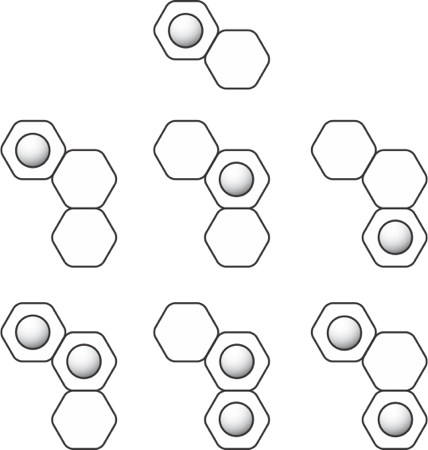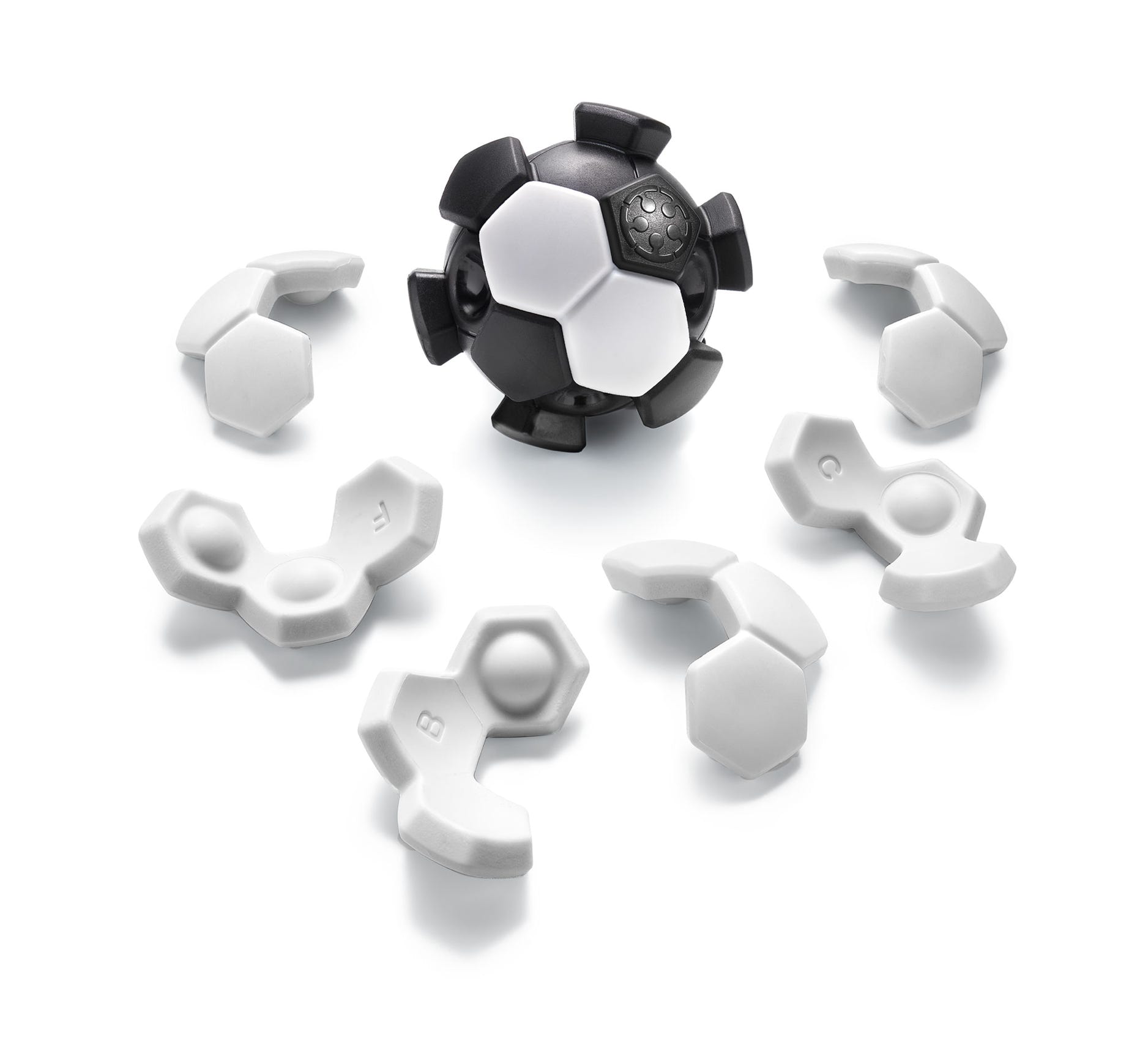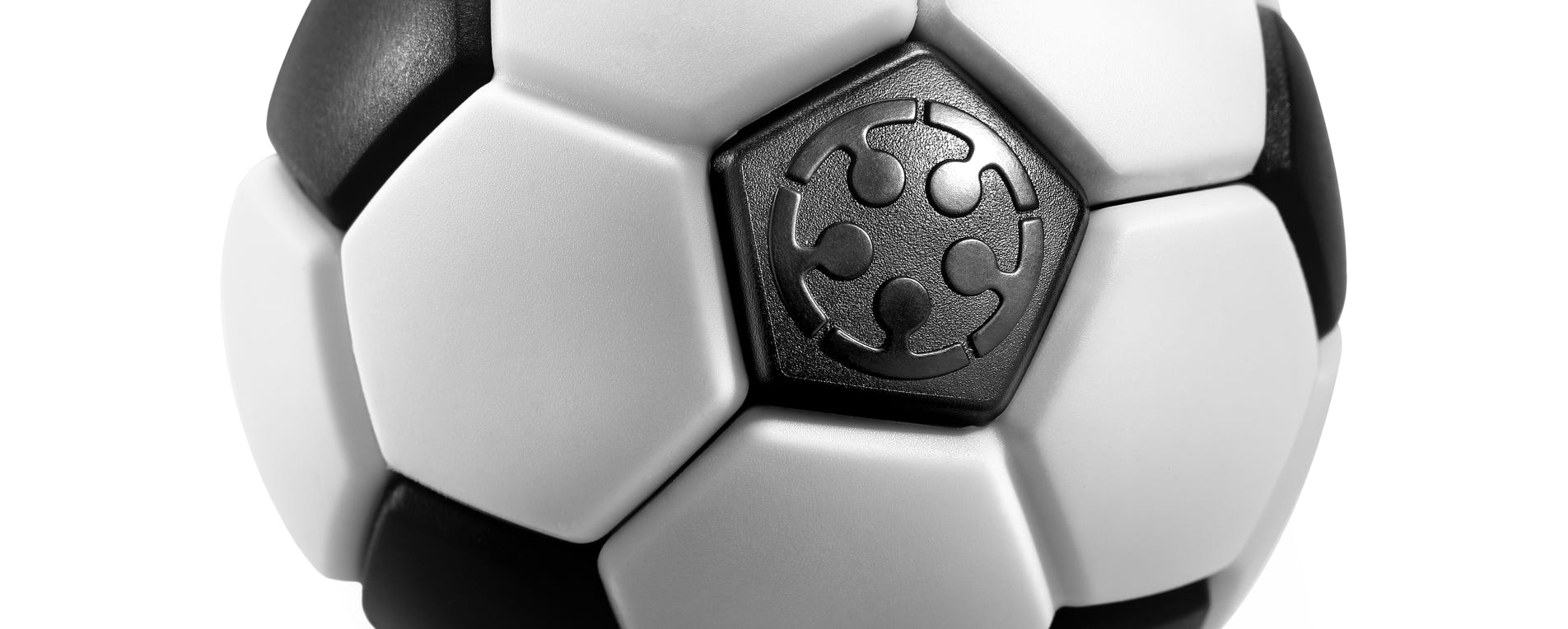
Plug & Play Ball
The product development of Plug & Play Ball (for SmartGames)
Raf Peeters, January 2023
For anyone who knows me better, this is probably the most unexpected puzzle game I ever designed. Because I am not really a sports fan too put it mildly. But the basic idea was to make a variation of Plug & Play Puzzler. That’s one of my favorite designs because of the simplicity of the concept. I already designed a few game in the shape of a cube, so the next logical step was to check if it was also possible to do something similar with a ball shape and no ball shape is more iconic than the black and white football (or soccer ball for people in the US).
FIDGET BALL
In Plug & Play Puzzler both the structure and the puzzle pieces are based on little cubes. But in this ball the black structure is made by a central core with 12 pentagons visible on the outside. The 7 white puzzle pieces are made of hexagons and fit in between these fixed pentagons. My colleague Leighton designed a great way how to produce and assemble this inner core in the factory in 5 parts, by only using snaps. This is lot easier in assembly than for example the construction of the white structure of Plug & Play Puzzler which requires more complex steps.
There are 6 pieces made of 3 hexagons and 1 piece made of 2 hexagons. Other combinations were not interesting. Theoretically I could also make puzzle pieces made of 4 hexagons, but it would be very hard or even impossible to make them fit inside the black structure. The black pentagons would obstruct this movement. In a cube you have 6 different sides, so you can place a piece inside the frame if you slide it in 1 specific direction. But in a ball every hexagon needs to be pushed in the direction of the centre of the ball shape, which means that all hexagons segments have a different angle. You can compensate a bit for this by using a flexible material, but the more hexagons you use in your pieces the harder it becomes to make them fit, especially if they are thick like in this game.
When most puzzle pieces are made of 3 hexagons you don’t have many options for their shape. They can either be straight, curved or all 3 adjacent to each other. But only the curved ones exist on the surface of this football. This left me with 6 identical puzzle pieces. Not very interesting if you want to make a puzzle game with multiple challenges. The solution to this design problem was to make all pieces different at their bottom side by adding 1 or 2 dome shapes. So although they look identical on the outside, they are all different. There are dimples inside the black structure to make space for these domes. This also removed all symmetry in this black part, which should result in different solutions, depending on where an how you started. The letters on the bottom side have no function during game play. They are only there to help customers who lost a part and to identify which replacement part needs to be sent.
My colleague Saskia wrote a program to calculate all possible challenges. We tried different setups for the dimples inside the black structure and found an interesting one that could be filled in 54 different ways, which is almost the same number as the Plug & Play Puzzler that has 57. So far, so good. Except when we looked at the challenges and solutions we realized it would be very hard for a player to know the following:
- Where to place the puzzle pieces in the black frame during the setup.
- How to keep track of your progress. Which pieces are the ones from the challenge and which are the ones you put inside the frame. In Plug and Play Puzzler each piece has its own color and shape, but in this P&P Ball all pieces have the same shape on the outside AND are white.
To make this game playable, I changed the concept of it. This game doesn’t come with a challenge booklet. There is 1 puzzle piece which is easy to identify and that is the one with only 2 hexagons. Play testing proved that every setup with this puzzle piece (on a valid position) results in at least one solution. To be more precise, there are 24 valid starting positions for this small piece:
• 10 challenges have a unique solution
• 4 challenges have 2 solutions
• 4 challenges have 3 solutions
• 6 challenges have 4 solutions
Of course you never know when you start how many solutions the challenge will have. So this game doesn’t come with levels, like most other SmartGames. All this info is interesting for statistics or mathematicians, but not very relevant for the game. It doesn’t really matter if there are 54 or 10 000 packings, because it’s impossible to keep track of what you already tried and what not. Even if there were less (or more), you would not never notice this.
This game is therefor more a fidget toy and less a logic puzzle, because you can’t really solve it using deduction. You will mainly need patience and perseverance. If you want a similar puzzle that you can solve with logic and 3D spatial insight, you should try Plug & Play Puzzler or Criss Cross Cube instead. Hint for someone who wants to quickly solve this game when he is finished and wants to clean it up: Instead of starting with the small piece, just keep it until last. This will make finding a solution a lot easier. And if you like to have it sitting a on a shelve, just leave this piece out, to avoid that the ball starts rolling. Plug & Play Ball will become available in Spring 2023.

The position of the domes on the bottom side of the 7 puzzle pieces of Plug & Play Ball

GAME RULES PLUG & PLAY BALL
1) Remove all the puzzle pieces from the ball before you start. There are 7 pieces: 6 made of 3 hexagons and 1 made of 2 hexagons. Start by placing the smaller piece (2 hexagons) on any of the 24 valid starting positions on the ball. This starting puzzle piece should always cover 1 place on the ball with a dimple and 1 place without a dimple. If it covers 2 dimples the game cannot be solved!
2) Fit the 6 other pieces on the ball, WITHOUT removing or replacing the small starting piece. Bumps on the bottom side of the pieces should fit inside dimples on the ball.
3) You have found a solution when all pieces fit inside the ball. Often several solutions are possible.
Website ©2023 Raf Peeters
Products and images: © Smart
